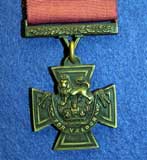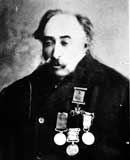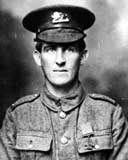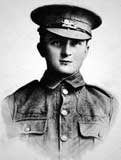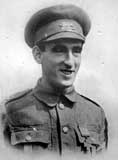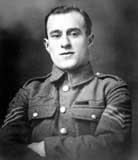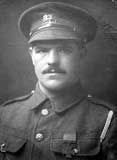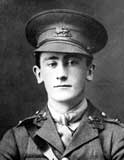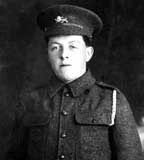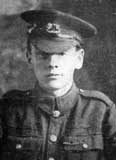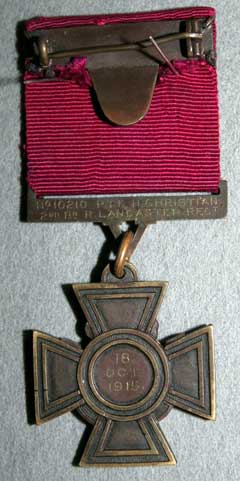 |
King's Own Royal Regiment Museum Lancaster |
|||||
|
HOME Museum & Collections Sales Donations Events Contact Us REGIMENTAL HISTORY 17th Century 18th Century 19th Century 20th Century First World War Second World War Actions & Movements Battle Honours FAMILY HISTORY Resources Further Reading PHOTO GALLERY ENQUIRIES FURTHER READING LINKS |
MEDAL INFORMATION Victoria Cross Face
Reverse Size
and Composition
Ribbon Bars In September 1916 it was decided that when only the ribbon strip of the VC is worn, a replica cross in miniature should be affixed to the centre. This distinguished the ribbon of the Victoria Cross from that of the Army Long Service and Good Conduct medal. Further miniatures are affixed for each bar awarded to the VC. The bottom of the ribbon passes through a slot in a rectangular bronze suspension bar, the lower part of which is embellished on the face with a laurel spray. Beneath this bar is affixed a V-shaped loop which is connected, by a small ring, to a loop cast integrally to the top edge of the upper arm of the Cross.
Naming
Awarded As the Crimean Campaign progressed there was a growing public awareness of the acts of gallantry being performed in the field. The country was also increasingly aware of the more enlightened system of rewards for gallantry applied by Britain’s principal ally in the Crimea - France - with its Legion of Honour of different grades open to all ranks. After much debate this led to the institution of the supreme honour, under the British Crown, of the Victoria Cross. On 29th January 1856 a Royal Warrant ordained, inter alia: “That the Cross shall only be awarded to those officers and men who have served us in the presence of the enemy and shall have performed some signal act of valour or devotion to their country.” “With a view to place all persons on a perfectly equal footing in relation to eligibility for the Decoration, that neither rank nor long service nor wounds nor any other circumstance or condition whatsoever save merit of conspicuous bravery shall be held to establish sufficient claim to the honour.” “Every....non-commissioned officer or Soldier (Seaman or Marine) who shall receive the Cross shall....be entitled to a Special Pension of ten pounds a year, and each additional bar conferred shall carry with it an additional Five pounds per annum” Provision was made for ballots for a certain number of awards of the Cross to be made where a group or body performed an act where all are equally brave; for forfeiture of the award and pension in the case of conviction for Treason, Cowardice, Felony or of any Infamous Crime; and for the restoration of the award in full in appropriate circumstances. Strict rules were also made for establishing conclusive proof of the act for which a claim to the award is made; for the making and consideration of claims; and for the recording, publication, conferring and wearing of the award. Numerous subsequent warrants extended the eligibility for the award: to cover certain acts of bravery “not before the enemy”, although currently it is ordained that “the Cross shall only be awarded for most conspicuous bravery or some daring or pre-eminent act of valour or self-sacrifice or extreme devotion to duty in the presence of the enemy”; to officers and men of the Royal Air Force, the volunteer, colonial, protectorate, dominion and commonwealth armed services and the Home Guard; to members of the Merchant Navy, the Naval, Military and Air Force Nursing Services and the Women’s Auxiliary Services; to civilians of either sex serving regularly or temporarily under the orders or supervision of the Royal Navy, the Army, or of any of the above mentioned Forces and Services; and to the making of posthumous awards. Provision was also made for the pension attached to any VC awarded after 31 July 1959 to be increased to one hundred pounds per year, with special alternative provisions for pensions for overseas recipients. The Victoria Cross and the George Cross (instituted in 1940) are the only British decorations to take precedence over the Orders of Knighthood. The first investiture of the VC was held in Hyde Park, London, on 26th June 1857 when Queen Victoria presented awards to sixty-two of the one hundred and eleven Crimean War recipients. A total of 1350 Victoria Crosses have been awarded, all to men, three of whom gained second award bars. An additional posthumous award was made in 1921 to the Unknown Warrior of the United States of America. A large majority of VC awards have been to the Army, as may be expected, and there have been four awards to civilians, three for the Indian Mutiny and one for the Second Afghan War. Eight Crosses have been forfeited. The
King’s Own
|

